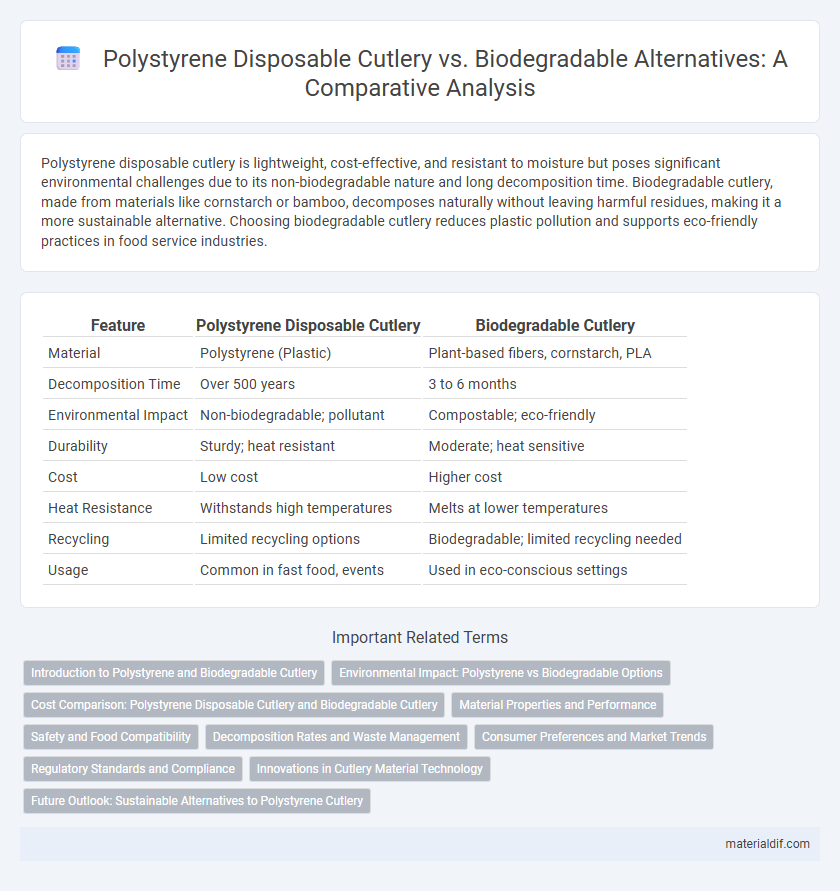Polystyrene disposable cutlery is lightweight, cost-effective, and resistant to moisture but poses significant environmental challenges due to its non-biodegradable nature and long decomposition time. Biodegradable cutlery, made from materials like cornstarch or bamboo, decomposes naturally without leaving harmful residues, making it a more sustainable alternative. Choosing biodegradable cutlery reduces plastic pollution and supports eco-friendly practices in food service industries.
Table of Comparison
| Feature | Polystyrene Disposable Cutlery | Biodegradable Cutlery |
|---|---|---|
| Material | Polystyrene (Plastic) | Plant-based fibers, cornstarch, PLA |
| Decomposition Time | Over 500 years | 3 to 6 months |
| Environmental Impact | Non-biodegradable; pollutant | Compostable; eco-friendly |
| Durability | Sturdy; heat resistant | Moderate; heat sensitive |
| Cost | Low cost | Higher cost |
| Heat Resistance | Withstands high temperatures | Melts at lower temperatures |
| Recycling | Limited recycling options | Biodegradable; limited recycling needed |
| Usage | Common in fast food, events | Used in eco-conscious settings |
Introduction to Polystyrene and Biodegradable Cutlery
Polystyrene disposable cutlery, made from a petroleum-based plastic, offers durability and low production costs but poses significant environmental challenges due to its non-biodegradable nature. Biodegradable cutlery, often derived from plant-based materials like cornstarch or sugarcane, decomposes naturally within months, reducing landfill waste and pollution. The comparison highlights the trade-off between the convenience and affordability of polystyrene and the eco-friendly benefits of biodegradable alternatives.
Environmental Impact: Polystyrene vs Biodegradable Options
Polystyrene disposable cutlery contributes significantly to environmental pollution due to its non-biodegradable nature and slow decomposition rate, often taking hundreds of years to break down in landfills. Biodegradable cutlery, typically made from materials like cornstarch or PLA, reduces waste accumulation by decomposing within months under proper composting conditions, thereby lowering the ecological footprint. The choice between polystyrene and biodegradable options directly impacts carbon emissions, landfill space, and marine pollution, with biodegradable alternatives providing a more sustainable solution for single-use utensils.
Cost Comparison: Polystyrene Disposable Cutlery and Biodegradable Cutlery
Polystyrene disposable cutlery is significantly cheaper than biodegradable cutlery, with prices often up to 50-70% lower due to mass production and lower material costs. Biodegradable cutlery typically involves higher raw material expenses and manufacturing processes, driving prices upward by 30-100% compared to polystyrene alternatives. Cost efficiency makes polystyrene cutlery a preferred choice for large-scale events despite growing environmental concerns.
Material Properties and Performance
Polystyrene disposable cutlery offers rigidity, low cost, and resistance to moisture but lacks biodegradability, leading to environmental persistence. Biodegradable cutlery, commonly made from materials like cornstarch or PLA, provides compostability and reduced environmental impact while sometimes compromising on heat resistance and mechanical strength. Performance trade-offs often include durability and thermal tolerance, with polystyrene excelling in structural stability and biodegradable options prioritizing eco-friendly decomposition.
Safety and Food Compatibility
Polystyrene disposable cutlery offers high food compatibility due to its resistance to heat and chemical inertness, ensuring no harmful substances leach into food during use. Biodegradable cutlery, often made from materials like cornstarch or PLA, prioritizes environmental sustainability but may have lower heat resistance and potential for chemical interaction with acidic or hot foods. Safety assessments show polystyrene's stable molecular structure reduces risk of contamination, whereas biodegradable alternatives require careful evaluation to meet food safety standards under diverse use conditions.
Decomposition Rates and Waste Management
Polystyrene disposable cutlery typically takes hundreds of years to decompose, contributing significantly to long-term environmental pollution in landfills and marine ecosystems. In contrast, biodegradable cutlery, made from materials like cornstarch or PLA, decomposes within months under industrial composting conditions, reducing waste accumulation and promoting sustainable disposal. Effective waste management strategies prioritize biodegradable cutlery to minimize plastic pollution and enhance composting infrastructure for faster organic decomposition.
Consumer Preferences and Market Trends
Consumer preferences increasingly favor biodegradable cutlery over polystyrene disposable cutlery due to growing environmental awareness and demand for sustainable products. Market trends indicate a shift towards biodegradable options, driven by stricter regulations and rising corporate commitments to reduce plastic waste. Despite the lower cost and durability of polystyrene cutlery, its declining popularity reflects a broader consumer shift toward eco-friendly alternatives.
Regulatory Standards and Compliance
Polystyrene disposable cutlery often faces stringent regulatory challenges due to its environmental impact and limited biodegradability, with many regions imposing restrictions or bans under plastic reduction mandates. Biodegradable cutlery complies with evolving global standards such as ASTM D6400 and EN 13432, ensuring materials break down under specific composting conditions and meet safety criteria for chemical residues. Regulatory bodies increasingly favor biodegradable options to meet sustainability goals and reduce plastic pollution, influencing procurement policies in foodservice and retail sectors.
Innovations in Cutlery Material Technology
Innovations in cutlery material technology have led to the development of biodegradable alternatives that address the environmental concerns associated with polystyrene disposable cutlery, which is derived from non-renewable petroleum sources and contributes significantly to plastic pollution. Biodegradable cutlery leverages materials such as plant-based polymers, cornstarch composites, and cellulose that decompose more rapidly and reduce landfill accumulation. Advances in biopolymer engineering and additive manufacturing enhance the durability and temperature resistance of biodegradable cutlery, narrowing the performance gap with traditional polystyrene products.
Future Outlook: Sustainable Alternatives to Polystyrene Cutlery
Biodegradable cutlery made from materials such as cornstarch, bamboo, and PLA (polylactic acid) offers a promising future as sustainable alternatives to traditional polystyrene disposable cutlery due to their lower environmental impact and compostability. Advances in biopolymer technology continue to improve the durability and cost-effectiveness of biodegradable cutlery, aiming to match or exceed the performance of polystyrene in food service applications. Regulatory pressures and increasing consumer demand for eco-friendly products are accelerating the shift towards these sustainable solutions in the disposable cutlery market.
Polystyrene Disposable Cutlery vs Biodegradable Cutlery Infographic

 materialdif.com
materialdif.com